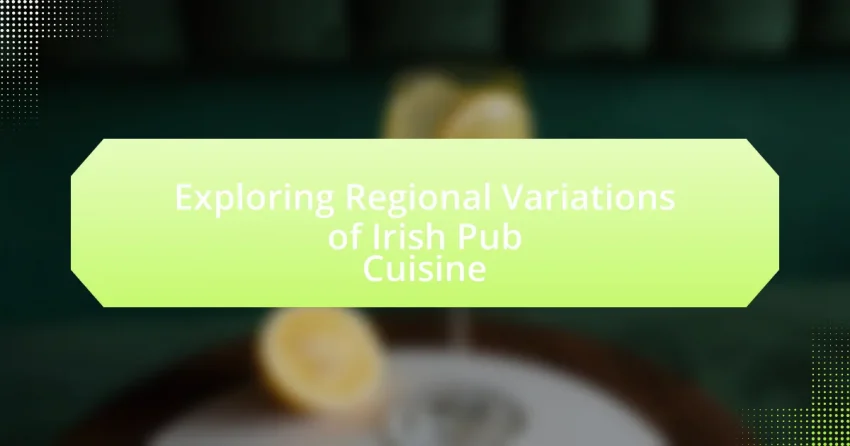The article focuses on the exploration of regional variations in Irish pub cuisine, highlighting its key characteristics, ingredients, and cooking methods. It distinguishes Irish pub cuisine from traditional Irish cuisine by emphasizing casual dining and comfort food, while also showcasing the influence of local ingredients and historical events on the dishes served. The article discusses the role of communal dining, social customs, and modern trends, including sustainability and fusion cuisines, that shape the contemporary landscape of Irish pub food. Additionally, it provides insights into best practices for enjoying Irish pub cuisine and tips for selecting the best dishes when dining in these establishments.

What are the key characteristics of Irish pub cuisine?
Irish pub cuisine is characterized by hearty, comforting dishes that often feature locally sourced ingredients. Traditional meals include staples such as Irish stew, made with lamb or beef, potatoes, and root vegetables, reflecting the agricultural heritage of Ireland. Additionally, dishes like fish and chips and boxty (a type of potato pancake) highlight the importance of seafood and potatoes in Irish cooking. The use of simple, robust flavors, often enhanced by herbs like parsley and thyme, is a hallmark of this cuisine. Furthermore, Irish pub cuisine frequently emphasizes communal dining, with sharing platters and a focus on social interaction, which is integral to the pub experience.
How does Irish pub cuisine differ from traditional Irish cuisine?
Irish pub cuisine differs from traditional Irish cuisine primarily in its emphasis on casual dining and a focus on comfort food. While traditional Irish cuisine often features hearty, home-cooked meals like Irish stew and colcannon, Irish pub cuisine tends to offer a more varied menu that includes items such as fish and chips, burgers, and a range of appetizers like wings and nachos. This shift reflects the pub’s role as a social gathering place, where quick, shareable dishes are favored. Additionally, Irish pub cuisine often incorporates international influences, adapting traditional recipes to suit a broader palate, which is less common in traditional Irish cooking that typically adheres to regional ingredients and methods.
What ingredients are commonly used in Irish pub dishes?
Common ingredients used in Irish pub dishes include potatoes, lamb, beef, fish, cabbage, and various herbs and spices. Potatoes serve as a staple, often featured in dishes like colcannon and boxty. Lamb and beef are frequently used in stews and pies, reflecting traditional Irish farming practices. Fish, particularly cod and salmon, is popular due to Ireland’s coastal geography. Cabbage is commonly included in dishes such as Irish stew and served alongside meats. Herbs like parsley and thyme enhance the flavors, showcasing the simplicity and heartiness characteristic of Irish cuisine.
How do cooking methods influence the flavors in Irish pub cuisine?
Cooking methods significantly influence the flavors in Irish pub cuisine by enhancing the natural tastes of ingredients through techniques such as boiling, roasting, and frying. For instance, boiling is commonly used for traditional dishes like Irish stew, allowing the flavors of meat and vegetables to meld together, resulting in a rich and hearty taste. Roasting, often applied to meats like lamb or beef, caramelizes the exterior, adding depth and complexity to the flavor profile. Frying, particularly in the preparation of dishes like fish and chips, creates a crispy texture that contrasts with the soft interior, enhancing the overall sensory experience. These methods not only affect taste but also texture, contributing to the distinctive character of Irish pub cuisine.
What role does regionality play in Irish pub cuisine?
Regionality significantly influences Irish pub cuisine by dictating the availability of local ingredients and traditional cooking methods. Each region in Ireland showcases distinct culinary practices, such as the use of seafood in coastal areas like Galway, where fresh fish is a staple, or the emphasis on hearty meat dishes in the midlands, reflecting agricultural practices. Historical factors, such as the impact of local farming and fishing communities, further shape these regional specialties, leading to variations in dishes like stew or soda bread. For instance, the use of buttermilk in the south contrasts with the use of sour milk in the north, highlighting how local resources dictate culinary choices.
How do local ingredients shape the dishes served in Irish pubs?
Local ingredients significantly shape the dishes served in Irish pubs by influencing flavor profiles and promoting regional culinary traditions. The use of locally sourced produce, meats, and dairy ensures that dishes reflect the unique tastes and seasonal availability of the area. For example, traditional Irish dishes like Irish stew often feature lamb or beef from nearby farms, while seafood chowder utilizes fresh catches from local waters. This reliance on local ingredients not only enhances the authenticity of the cuisine but also supports local economies and sustainable practices, as seen in the increasing popularity of farm-to-table initiatives across Ireland.
What are some examples of regional specialties found in Irish pubs?
Regional specialties found in Irish pubs include dishes such as Irish stew, which is a traditional lamb or beef stew with potatoes and vegetables, and boxty, a type of potato pancake originating from the northern regions. Additionally, seafood chowder, particularly popular along the coasts, features local fish and shellfish. In the west, you may find colcannon, a dish made from mashed potatoes mixed with cabbage or kale. These dishes reflect the local ingredients and culinary traditions of various regions in Ireland, showcasing the diversity of Irish pub cuisine.

How have historical influences shaped Irish pub cuisine?
Historical influences have significantly shaped Irish pub cuisine through the integration of various cultural and agricultural practices. The Viking invasions introduced new ingredients and cooking techniques, while the British rule brought about the use of potatoes, which became a staple in Irish diets. The Great Famine in the 19th century further transformed cuisine, leading to a reliance on simple, hearty dishes that utilized locally available ingredients. Additionally, the influence of Irish immigrants in the United States led to the popularization of dishes like Irish stew and soda bread, which have since become synonymous with Irish pub fare. These historical events collectively contributed to the rich and diverse culinary landscape found in Irish pubs today.
What historical events have impacted the evolution of Irish pub food?
The evolution of Irish pub food has been significantly impacted by several historical events, including the Great Famine of the 1840s, British colonial rule, and the rise of tourism in the 20th century. The Great Famine led to a scarcity of ingredients and a shift towards simpler, more affordable dishes, as many traditional foods became inaccessible. British colonial rule introduced new ingredients and cooking techniques, which influenced the incorporation of diverse flavors into Irish cuisine. Additionally, the rise of tourism in the 20th century prompted pubs to adapt their menus to cater to international tastes, leading to a fusion of traditional Irish dishes with global culinary trends. These events collectively shaped the contemporary landscape of Irish pub food, reflecting both historical hardships and cultural exchanges.
How did immigration influence the development of Irish pub cuisine?
Immigration significantly influenced the development of Irish pub cuisine by introducing diverse culinary traditions and ingredients. As Irish emigrants settled in various countries, particularly the United States, they adapted their traditional dishes to incorporate local flavors and available resources. For instance, the introduction of American ingredients like corn and various meats led to the creation of dishes such as corned beef and cabbage, which became emblematic of Irish-American cuisine. Additionally, the blending of Irish cooking techniques with those of other immigrant groups resulted in unique regional variations, such as the fusion of Irish and Italian cuisines in cities like Boston and New York. This evolution reflects the adaptability of Irish pub cuisine, shaped by the cultural exchanges that immigration facilitated.
What traditional dishes have persisted through generations in Irish pubs?
Traditional dishes that have persisted through generations in Irish pubs include Irish stew, shepherd’s pie, and fish and chips. Irish stew, made with lamb or beef, potatoes, and root vegetables, has roots dating back to the 18th century, reflecting the simplicity and heartiness of Irish cooking. Shepherd’s pie, a meat pie topped with mashed potatoes, originated in the 19th century as a way to use leftover meat. Fish and chips, introduced in the 19th century, became a staple due to the availability of fresh fish along the Irish coast. These dishes not only represent the culinary heritage of Ireland but also continue to be popular choices in pubs today, showcasing the enduring nature of traditional Irish cuisine.
How do cultural traditions influence dining in Irish pubs?
Cultural traditions significantly influence dining in Irish pubs by shaping the menu offerings, dining practices, and social interactions. Traditional Irish cuisine, which includes dishes like stew, soda bread, and seafood, reflects the agricultural and maritime heritage of Ireland, emphasizing locally sourced ingredients. Furthermore, the communal aspect of dining in Irish pubs encourages sharing and socializing, rooted in the Irish value of hospitality. This is evident in the practice of enjoying meals alongside drinks, often accompanied by music and storytelling, which enhances the dining experience. The importance of these traditions is supported by the fact that Irish pubs often serve as community hubs, fostering connections among patrons and preserving cultural identity.
What are the social customs associated with eating in Irish pubs?
Social customs associated with eating in Irish pubs include communal dining, sharing plates, and a relaxed atmosphere that encourages conversation. Patrons often order food to share, fostering a sense of community and connection among diners. Additionally, it is customary to enjoy meals alongside drinks, typically beer or whiskey, which enhances the social experience. The tradition of live music in many pubs further enriches the dining atmosphere, making it a lively and engaging environment. These customs reflect the cultural importance of hospitality and social interaction in Irish society.
How do festivals and celebrations affect the menu offerings in Irish pubs?
Festivals and celebrations significantly influence the menu offerings in Irish pubs by introducing seasonal and culturally relevant dishes. During events like St. Patrick’s Day, pubs often feature traditional Irish foods such as corned beef and cabbage, Irish stew, and soda bread, which cater to both locals and tourists seeking an authentic experience. Additionally, local festivals may inspire the inclusion of regional specialties, such as seafood dishes during the Galway International Oyster and Seafood Festival, reflecting the area’s culinary heritage. This adaptation not only enhances the dining experience but also boosts sales during peak celebration periods, as evidenced by increased foot traffic and customer demand for themed menu items.

What are the modern trends in Irish pub cuisine?
Modern trends in Irish pub cuisine include a focus on locally sourced ingredients, innovative takes on traditional dishes, and the incorporation of international flavors. Many pubs are now emphasizing farm-to-table practices, showcasing seasonal produce and meats from nearby farms, which enhances freshness and supports local economies. Additionally, chefs are reinterpreting classic Irish meals, such as using gourmet techniques in preparing shepherd’s pie or introducing fusion elements like Asian spices in traditional stews. This evolution reflects a broader culinary movement towards sustainability and creativity in dining experiences, appealing to both locals and tourists seeking authentic yet modern interpretations of Irish food.
How are contemporary chefs reinventing traditional Irish pub dishes?
Contemporary chefs are reinventing traditional Irish pub dishes by incorporating modern cooking techniques and diverse global flavors. For example, chefs are using sous-vide methods to enhance the tenderness of classic dishes like beef and Guinness stew, while also introducing ingredients such as Asian spices or Mediterranean herbs to create fusion variations. This approach not only modernizes the presentation but also elevates the flavor profiles, appealing to a broader audience. Additionally, many chefs focus on sourcing local and seasonal ingredients, which aligns with the farm-to-table movement, ensuring freshness and sustainability in their reinterpretations of traditional recipes.
What fusion cuisines are emerging in Irish pubs today?
Emerging fusion cuisines in Irish pubs today include Asian-Irish, Mexican-Irish, and Mediterranean-Irish combinations. Asian-Irish fusion often features dishes like Irish stew with Asian spices or sushi made with traditional Irish ingredients. Mexican-Irish cuisine introduces elements such as tacos filled with Irish lamb or nachos topped with Irish cheese. Mediterranean-Irish blends utilize ingredients like hummus made from Irish potatoes or seafood dishes incorporating Mediterranean herbs. These trends reflect a growing interest in diverse culinary influences within the traditional Irish pub setting, catering to evolving tastes and preferences.
How is sustainability being incorporated into Irish pub menus?
Sustainability is being incorporated into Irish pub menus through the use of locally sourced ingredients, seasonal produce, and environmentally friendly practices. Many Irish pubs prioritize partnerships with local farmers and suppliers to reduce carbon footprints and support the local economy. For example, pubs often feature dishes made from ingredients that are in season, which not only enhances flavor but also minimizes the environmental impact associated with transportation. Additionally, some establishments are adopting practices such as composting food waste and using biodegradable packaging, further demonstrating their commitment to sustainability. This trend reflects a growing awareness among consumers and businesses alike regarding the importance of sustainable dining options in the hospitality industry.
What are the best practices for enjoying Irish pub cuisine?
To enjoy Irish pub cuisine, it is best to embrace traditional dishes such as Irish stew, fish and chips, and soda bread, while pairing them with local beverages like Guinness or Irish whiskey. Engaging with the pub’s atmosphere enhances the experience, as many Irish pubs feature live music and a communal vibe that reflects the culture. Additionally, sharing dishes with friends fosters a sense of community, which is integral to the Irish dining experience. The emphasis on hearty, locally sourced ingredients in Irish cuisine, such as lamb and root vegetables, further enriches the authenticity of the meal.
How can diners choose the best dishes when visiting an Irish pub?
Diners can choose the best dishes when visiting an Irish pub by considering traditional favorites, local specialties, and seasonal ingredients. Traditional favorites like Irish stew, fish and chips, and shepherd’s pie are often well-prepared and reflect authentic Irish cuisine. Local specialties may vary by region, showcasing unique ingredients or cooking methods specific to that area, such as seafood dishes in coastal pubs. Additionally, seasonal ingredients often lead to fresher and more flavorful options, as many Irish pubs emphasize farm-to-table practices. By asking staff for recommendations and observing popular dishes among other patrons, diners can further enhance their dining experience and select the best offerings available.
What tips can enhance the overall experience of dining in an Irish pub?
To enhance the overall experience of dining in an Irish pub, patrons should engage with the local culture by trying traditional dishes and beverages unique to the region. For instance, enjoying a classic Irish stew or a locally brewed stout not only supports regional cuisine but also provides an authentic taste of Irish heritage. Additionally, participating in live music events, which are common in many Irish pubs, can create a lively atmosphere that enriches the dining experience. Research indicates that immersive cultural experiences, such as enjoying local music and cuisine, significantly enhance customer satisfaction in dining settings.
